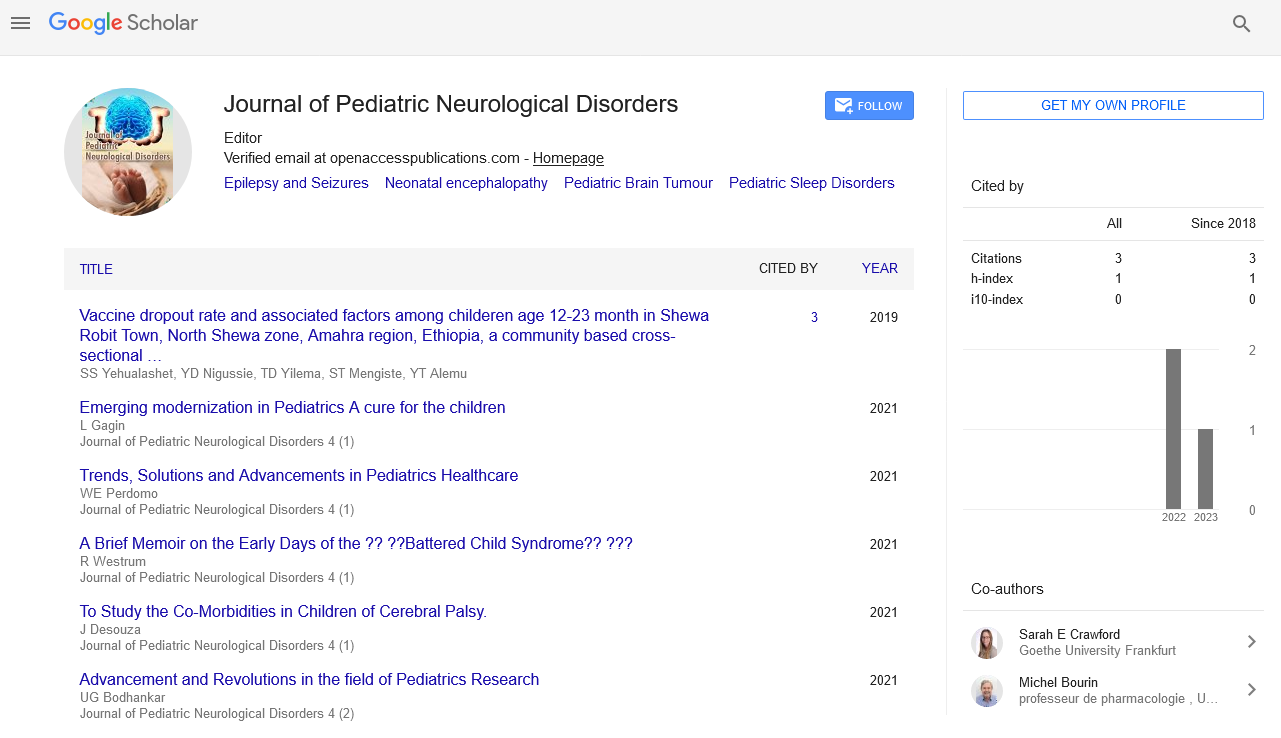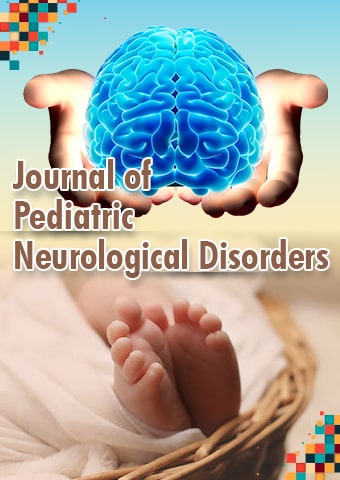Review Article - Journal of Pediatric Neurological Disorders (2023) Volume 6, Issue 4
Hospital Use among Children Serving by Paediatric Neurology Telemedicine Clinics in Rural Areas
Jonathon Clayfield*
Department of Neurobiology, UCI medical Center of Neurobiology, California, USA
Department of Neurobiology, UCI medical Center of Neurobiology, California, USA
E-mail: clayfield.jonath@uci.ac.com
Received: 01-Aug-2023, Manuscript No. pnn-23-111455; Editor assigned: 07-Aug-2023, PreQC No. pnn-23- 111455(PQ); Reviewed: 14- Aug- 2023, QC No. pnn-23-111455; Revised: 22-Apr-2023, Manuscript No. pnn-23-111455; Published: 31-Aug-2023, DOI: 10.37532/ pnn.2023.6(4).100-102
Abstract
Exposures
Consultation modality (telemedicine or in person) in the outpatient neurology clinics.
Principal results and actions
The hospital's electronic medical records were mined for demographic and clinical data. The relationship between patients' use of the emergency room and hospitalizations and the type of outpatient neurology care was assessed. Multivariable negative binomial regression was used to examine hospital utilization related to both all-cause and neurologic conditions in both the overall and matched samples.
Conclusion
When compared to in-person consultations, real-time, audiovisual telemedicine care for pediatric neurology patients was related with lower hospital utilization, showing that high-cost hospital encounters can be avoided by enhancing subspecialty access.
Keywords
Consultation modality • Out patience neurology clinics • Electronic medical data • Hospital utilization • Pediatric neurology
Introduction
For underserved patients, real-time telemedicine consultations can make specialist appointments less time-consuming and expensive. Since 2009, primary care clinics in underserved neighborhoods of California have been able to receive outpatient pediatric neurology treatments from University of California Davis Children's Hospital (UCDCH) via telemedicine. In a recent study we discovered that, when compared to in-person visits, these pediatric neurology telemedicine appointments are more likely to be completed as opposed to cancelled or missed (i.e.no-show) among a cohort of kids [1].
Population study
Patients under the age of 18 whose registered homes were located within the 33-county service area of UCDCH in northern California and who had at least one clinic visit with a pediatric neurologist between January 1, 2009, and July 31, 2017, either in person or via telemedicine, made up the study population. The telemedicine cohort was linked to appointment attendance at the neurology clinic. We assessed hospital contact rates in matched subsets of the study cohort to test the validity of our findings. To examine the rates among cohorts living in remote locations, we first matched the telemedicine and in-person cohorts on travel time to UCDCH using a metric of 5 minutes in a 1:1 ratio (without replacement). In order to compare hospital encounter rates among cohorts with similar access to outpatient neurology care, with respect to travel time, we matched the cohorts on travel time to their neurology clinic (remote telemedicine clinics for the telemedicine cohort and in-person clinics at UCDCH for the in-person cohort). Because ED visits without hospitalization would be more likely to occur at UCDCH within the inperson group at baseline, regardless of the exposure, we restricted the outcome for this analysis to inpatient admissions [2, 3].
Cohorts in telemedicine and in-person
The age and sex distributions of the cohorts were similar, but 2.1% versus 36.6% fewer patients in the telemedicine group had private insurance than those in the in-person cohort. Patients in the telemedicine cohort were also more likely to reside in areas with lower education levels and median family incomes (mean [SD], $42 600 [$12 600] vs. $69 300 [$29 600]). For outpatient neurology care, the mean (SD) journey time for the telemedicine group was 20.6 (24.4) minutes, whereas the travel time for the in-person cohort was 48.0 (52.4) minutes. The telemedicine cohort's mean (SD) travel time to the UCDCH physical clinic was 156.0 (33.9) minutes in contrast. The completion rate of neurology clinic appointments was greater for the telemedicine group than the in-person cohort (mean [SD], 81.7% [23.5%] vs 75.7% [25.4%]). The distributions of patients with complicated chronic diseases and neurologic hospital diagnoses were consistent between the 2 cohorts, despite changes in the distribution of neurology clinic diagnoses across the cohorts [4, 5].
Discussion
There are some restrictions with this retrospective analysis. First, because patients were not randomly assigned to telemedicine or in-person clinics, there are inherent variations between the cohorts [6, 7]. In order to account for potential confounders, we used a multivariable model in an effort to overcome this restriction. Second, some patients may have had encounters at other hospitals that were not recorded in our data because we did not have access to their medical records from other community hospitals in the UCDCH's service area. In our study, hospital rates for patients who live in far-off communities might therefore be overestimated. By matching cohorts based on travel time to UCDCH (comparable risk of UCDCH hospital utilisation) and limiting our comparison to inpatient admissions among patients matched based on travel time to neurology clinics (comparable access to outpatient neurology care and comparable risk of admissions at UCDCH), we made an effort to overcome this limitation. Future research will need to provide more evidence to support whether the risk of a hospital encounter is equivalent in the matched analyses [8, 9]. Third, throughout the observation period for hospital interactions, patients were able to have telemedicine or in-person consultations at neurology clinics; as a result, the outcome did not necessarily chronologically follow the exposure [10].
Conclusion
Even in multivariable analysis and other matched studies, we discovered lower rates of hospital visits among children who received neurology care via telemedicine in their local communities as opposed to children who received neurology care in the in-person clinics. Our results imply that telemedicine may decrease the use of expensive hospital care for children by increasing specialist access in underprivileged locations and improving care coordination across doctors.
References
- McLeod H, Heath G, Cameron E et al. Introducing consultant outpatient clinics to community settings to improve access to paediatrics: an observational impact study. BMJ Qual Saf. 24, 377-384 (2015).
- Patel AD. Variables associated with emergency department and/or unplanned hospital utilization for children with epilepsy. Epilepsy Behav. 31, 172-175 (2014).
- Patel AD, Wood EG, Cohen DM. Reduced emergency department utilization by patients with epilepsy using QI methodology. Pediatrics. 139, e20152358 (2017).
- Patel AD, Terry D, Moore JP et al. Reduction of emergency department visits using an urgent clinic for children with established epilepsy. Neurol Clin Pract.
- Berry JG, Poduri A, Bonkowsky JL et al. Trends in resource utilization by children with neurological impairment in the United States inpatient health care system: a repeat cross-sectional study. PLoS Med. 9, e1001158 (2012).
- Nourazari S, Hoch DB, Capawanna S et al. Can improved specialty access moderate emergency department overuse? Effect of neurology appointment delays on ED visits. Neurol Clin Pract. 6, 498-505 (2016).
- Dall TM, Storm MV, Chakrabarti R et al. Supply and demand analysis of the current and future US neurology workforce. Neurology. 81, 470-478 (2013).
- Timpano F, Bonanno L, Bramanti A et al. Tele-health and neurology: what is possible? Neurol Sci. 34, 2263-2270 (2013).
- Dayal P, Chang CH, Benko WS et al. Appointment completion in pediatric neurology telemedicine clinics serving underserved patients. Neurol Clin Pract. (2019)
- Ronis SD, McConnochie KM, Wang H et al. Urban telemedicine enables equity in access to acute illness care. Telemed J E Health. 23, 105-112 (2017).
Indexed at, CrossRef, Google Scholar
Indexed at, CrossRef, Google Scholar
Indexed at, CrossRef, Google Scholar
Indexed at, CrossRef, Google Scholar
Indexed at, CrossRef, Google Scholar

